Novel immunofluorescence assay using recombinant nucleocapsid-spike fusion protein as antigen to detect antibodies against severe acute respiratory syndrome coronavirus
- PMID: 15699428
- PMCID: PMC549298
- DOI: 10.1128/CDLI.12.2.321-328.2005
Novel immunofluorescence assay using recombinant nucleocapsid-spike fusion protein as antigen to detect antibodies against severe acute respiratory syndrome coronavirus
Abstract
Severe acute respiratory syndrome (SARS) is caused by a novel and highly infectious virus named SARS coronavirus (SARS-CoV). Among the serological tests currently available for the detection of SARS-CoV, a whole-virus-based immunofluorescence assay (IFA) was considered one of the most sensitive assays and served as a "gold standard" during the SARS epidemic in Singapore in 2003. However, the need to manipulate live SARS-CoV in the traditional IFA limits its wide application due to the requirement for a biosafety level 3 laboratory and the risk of laboratory infection. Previously, we have identified two immunodominant epitopes, named N195 and Sc, in the two major structural proteins, the N and S proteins, of SARS-CoV (Q. He, K. H. Chong, H. H. Chng, B. Leung, A. E. Ling, T. Wei, S. W. Chan, E. E. Ooi, and J. Kwang, Clin. Diagn. Lab. Immunol., 11:417-422, 2004; L. Lu, I. Manopo, B. P. Leung, H. H. Chng, A. E. Ling, L. L. Chee, E. E. Ooi, S. W. Chan, and J. Kwang, J. Clin. Microbiol. 42:1570-1576, 2004). In the present study, the N195-Sc fusion protein was highly expressed in insect (Sf9) cells infected with a recombinant baculovirus bearing the hybrid gene under the control of a polyhedrin promoter. An IFA based on Sf9 cells producing the fusion protein was standardized with 23 serum samples from patients with SARS, 20 serum samples from patients with autoimmune diseases, and 43 serum samples from healthy blood donors. The detection rates were comparable to those obtained with a commercial SARS-CoV IFA kit (EUROIMMUN, Gross Groenau, Germany) and a conventional IFA performed at the Singapore General Hospital. Our data showed that the newly developed IFA could detect SARS-CoV in 22 of the 23 SARS-CoV-positive serum samples and gave no false-positive results when the sera from patients with autoimmune diseases and healthy individuals were tested. The detection rate was identical to those of the two whole-virus-based IFAs. Thus, the novel N-S fusion antigen-based IFA could be an attractive alternative to present whole-virus-based IFAs for the diagnosis of SARS-CoV infection.
Figures




References
-
- Drosten, C., S. Gunther, W. Preiser, S. van der Werf, H. R. Brodt, S. Becker, H. Rabenau, M. Panning, L. Kolesnikova, R. A. Fouchier, A. Berger, A. M. Burguiere, J. Cinatl, M. Eickmann, N. Escriou, K. Grywna, S. Kramme, J. C. Manuguerra, S. Muller, V. Rickerts, M. Sturmer, S. Vieth, H. D. Klenk, A. D. Osterhaus, H. Schmitz, and H. W. Doerr. 2003. Identification of a novel coronavirus in patients with severe acute respiratory syndrome. N. Engl. J. Med. 348:1967-1976. - PubMed
-
- Guan, Y., B. J. Zheng, Y. Q. He, X. L. Liu, Z. X. Zhuang, C. L. Cheung, S. W. Luo, P. H. Li, L. J. Zhang, Y. J. Guan, K. M. Butt, K. L. Wong, K. W. Chan, W. Lim, K. F. Shortridge, K. Y. Yuen, J. S. M. Peiris, and L. L. M. Poon. 2003. Isolation and characterization of viruses related to the SARS coronavirus from animals in southern China. Science 302:276-278. - PubMed
-
- Ksiazek, T. G., D. Erdman, C. S. Goldsmith, S. R. Zaki, T. Peret, S. Emery, S. Tong, C. Urbani, J. A. Comer, W. Lim, P. E. Rollin, S. F. Dowell, A. E. Ling, C. D. Humphrey, W. J. Shieh, J. Guarner, C. D. Paddock, P. Rota, B. Fields, J. DeRisi, J. Y. Yang, N. Cox, J. M. Hughes, J. W. LeDuc, W. J. Bellini, L. J. Anderson, and SARS Working Group. 2003. A novel coronavirus associated with severe acute respiratory syndrome. N. Engl. J. Med. 348:1953-1966. - PubMed
MeSH terms
Substances
LinkOut - more resources
Full Text Sources
Other Literature Sources
Miscellaneous

